Daily Current Affairs and GK | 18 December 2020

Main Headlines:
- 1. International Migrants Day: 18 December
- 2. Minorities Rights Day 2020: 18 December
- 3. Narcotics Control Bureau (India) and National Narcotics Board (Indonesia) conducted 4th Joint Working Group (JWG) meeting.
- 4. India’s ranking in Human Development Index (HDI) 2019 drops by two places.
- 5. Progress made under National Hydrology Project (NHP) reviewed by Jal Shakti Minister Gajendra Singh Shekhawat.
- 6. Seven MoUs and agreements signed between India and Bangladesh.
- 7. 35th IND - INDO CORPAT (India-Indonesia Coordinated Patrol) being carried out between Indian Navy and Indonesian Navy.
- 8. Shashi Sekhar Vempati elected as Vice President of Asia-Pacific Broadcasting Union.
- 9. Government recognized ‘Yogasana’ as a competitive sport.
- 10. China’s Chang’e 5 lunar mission returned with fresh samples from moon.
- 11. India ranked 111th in Human Freedom Index 2020.
Happy December get 35% Off
Use Coupon code DEC25
Topic: Important Days
1. International Migrants Day: 18 December
- It is observed every year on 18 December to raise awareness about the rights of the migrants.
- It is observed to mark the anniversary of adopting the International Convention on the Protection of the Rights of All Migrant Workers and Members of their Families by the United Nations General Assembly in 1990.
- UNGA had proclaimed 18 December as International Migration Day on 4 December 2000.
- International Migrants Day 2020 theme is “Reimagining Human Mobility”.
- This year’s International Migrants Day will be dedicated to protecting Migrants from the impact of COVID-19.
- The United Nations General Assembly had adopted a set of commitments for the protection of migrants. These commitments are known as the New York Declaration.
- Facts regarding migration in world:
- According to the UN, the number of international migrants has grown by 49% since 2000 and nearly half of the migrants are women.
- In the world, 31% of International migrants are in Asia, 26% in America, 10% in Africa and 30% in Europe.
2. Minorities Rights Day 2020: 18 December
- It is observed every year on 18 December to highlight the issues related to minorities in India.
- It is celebrated by the National Commission for Minorities (NCM) in India.
- This day is celebrated as the anniversary of adopting the Statement on the individual’s rights belonging to religious or Linguistic National or Ethnic Minorities in 1992.
- Government of India established the National Commission for Minorities in 1992 to protect minorities’ rights in India.
- Article 30 of the Indian constitution mentions two categories of minorities – religious and linguistic.
Topic: Summits/ Conferences/ Meetings
3. Narcotics Control Bureau (India) and National Narcotics Board (Indonesia) conducted 4th Joint Working Group (JWG) meeting.
- The 4th Joint Working Group meeting between Narcotics Control Bureau India and the National Narcotics Board of Indonesia had concluded on 17 December 2020.
- India raised the issue of trafficking of illegal drugs from the area of the Golden triangle through land and maritime routes in the meeting.
- India affirmed its cooperation with Indonesia in the fight against drug trafficking.
- Both countries agreed upon the exchange of information related to drug trafficking and smuggling activities.
- India will host the 5th India-Indonesia Bilateral Joint Working Group Meeting on Drug Control Cooperation in 2021.
- Golden Triangle: It is the world’s largest drug-producing zone. It broadly covers north-eastern Myanmar, northern Thailand, northern Laos and the north-eastern corner of Vietnam. This region is a major producer of opium poppy.
- Narcotics Control Bureau:
- It was established in 1986.
- It is a government agency under the Ministry of Home Affairs.
- It is responsible for tracking illegal drug trafficking and the implementation of international drug laws.
- Rakesh Asthana is the current Director-General of the Narcotics Control Bureau.
Topic: Reports and Indices/ Rankings
4. India’s ranking in Human Development Index (HDI) 2019 drops by two places.
- India’s ranking in Human Development Index (HDI) 2019 has dropped by two places from 129 to 131.
- India is ranked 131 out of 189 countries. The title of Human Development Report (HDR) 2020 is “The next frontier Human development and the Anthropocene”.
- HDR 2020 covers 2019 only. It does not explain the impact of Covid-19. HDR 2020 says that global HDI in 2020 would fall below for the first time in three decades since the introduction of HDI in 1990.
- UNDP has added Planetary Pressures-Adjusted Human Development Index (PHDI) in HDR 2020. It shows the impact of carbon dioxide emissions per person and material footprint per capita.
- Material footprint means the amount of materials (biomass, fossil fuels and ores) extracted by a country to meet demands of its goods and services.
- Norway is at the top of HDI. Ireland, Switzerland, Hong Kong, and Iceland come after Norway. If newly introduced PHDI is used, Norway’s rank changes from 1 to 15.
- As per HDR 2020, India falls in the list of countries with medium human development. The report shows a decline in India’s Gross National Income (GNI) per capita on the basis of purchasing power parity (PPP) from $6,829 in 2018 to $6,681 in 2019.
- India’s HDI value for 2019 is 0.645. It increased by 50.3% from 0.429 to 0.645 between 1990 and 2019. Changes in other indicators from 1990 to 2019 are given in the next table:
|
Indicator |
Changes in indicator |
|
Life expectancy at birth |
Increase by 11.8 years |
|
Mean years of schooling |
Increase by 3.5 years |
|
Expected years of schooling |
Increase by 4.5 years |
|
GNI per capita |
Increase by about 273.9% |
- Human Development Index (HDI):
- HDI is released by the United Nations Development Programme (UNDP) annually.
- The index assesses 189 countries based on three major indicators: Life Expectancy at Birth, Mean and expected years of schooling and Gross National Income per capita.
- UNDP:
- UNDP is UN’s global development network that was founded in 1965.
- Headquarters: New York
- Administrator: Achim Steiner
- UNDP works in about 177 countries to eradicate poverty, reduce inequality.
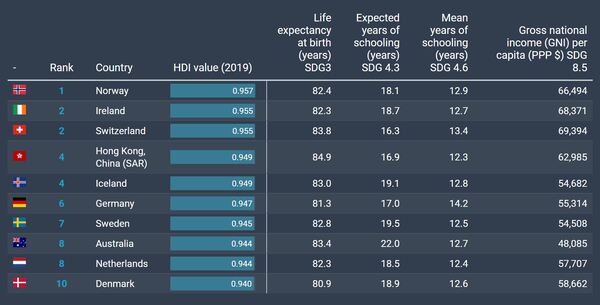
(Source: UNDP)
Topic: Government Schemes and Initiatives
5. Progress made under National Hydrology Project (NHP) reviewed by Jal Shakti Minister Gajendra Singh Shekhawat.
- Progress made under National Hydrology Project (NHP) has been reviewed by Jal Shakti Minister Gajendra Singh Shekhawat.
- The minister said that a nationwide repository of water resources data had been set up. The focus under NHP is now on the creation of a real-time data acquisition system (RTDAS) on pan India basis.
- Government had released rankings of NHP for May 2020 in June 2020. In this ranking, Kerala was ranked at second place in ground water category. Damodar Valley Corporation was ranked first in the same category.
- National Hydrology Project (NHP):
- It is a Central Sector Scheme. Government gives 100 % grant to implementing agencies of NHP.
- NHP has a budget outlay of 3680 crore rupees to be spent over a period of 8 years. It was started in 2016-17 and will continue till 2023-24.
- It is a World Bank assisted project. World Bank assistance is 50% of the project cost.
- It aims at making the extent, reliability and accessibility of water resources information better. It also aims to make the capacity of targeted water resource management institutions in India stronger.
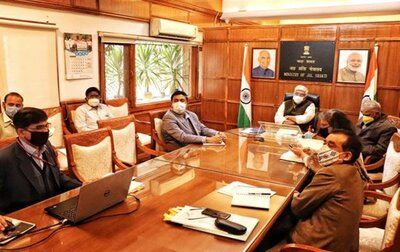
(Source: News on AIR)
Topic: MoUs/ Agreements
6. Seven MoUs and agreements signed between India and Bangladesh.
- Seven MoUs and agreements have been signed between India and Bangladesh during the virtual summit in which PMs of both countries participated.
- Chilahati – Haldibari rail route was also inaugurated by the leaders of both countries during the virtual summit.
- Both countries signed a framework of understanding in Hydrocarbon sector. They are already building India-Bangladesh Friendship Pipeline to supply High-speed diesel from Siliguri in India to Parbatipur in Bangladesh.
- The framework agreement on High Impact Community Development Project (HICDP) was signed. It is a ten-year agreement allowing projects in the field of education, health and sanitation, water-treatment, cultural heritage.
- Both countries also signed terms of reference for India Bangladesh CEO forum, a protocol on transborder elephant conservation and an MoU on the supply of equipment and improvement of Garbage and solid waste disposal.
- They signed an MoU in the field of agriculture and another MoU between the National Museum, Delhi and Bangabandhu Sheikh Mujibur Rahman Memorial Museum, Dhaka
- During the virtual summit, a digital exhibition on the life of Bangabandhu Sheikh Mujibur Rahman and Mahatma Gandhi was launched.
- Both leaders emphasized that Frameworks for the Interim Agreement on sharing the waters of six joint rivers other than Teesta need to be concluded soon. The names of these rivers are Manu, Muhuri, Khowai, Gumti, Dharla and Dudhkumar.
- Both leaders agreed that Joint River Commission meetings must be planned at the earliest.
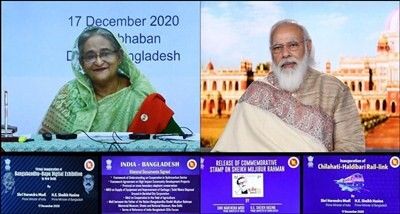
(Source: News on AIR)
Topic: Defence
7. 35th IND - INDO CORPAT (India-Indonesia Coordinated Patrol) being carried out between Indian Navy and Indonesian Navy.
- 35th IND - INDO CORPAT (India-Indonesia Coordinated Patrol) is being carried out between Indian Navy and Indonesian Navy from 17 to 18 December 2020.
- Indian and Indonesian navies are conducting CORPAT along their International Maritime Boundary Line since 2002.
- Under the Indian Government’s vision of SAGAR (Security And Growth for All in the Region), the Indian Navy has been engaging with Indian Ocean Region countries.
- Indian Navy does this for Coordinated Patrols, cooperation in Exclusive Economic Zone (EEZ) Surveillance and other reasons.
- The United Nations Convention on the Law of the Sea (UNCLOS) defines an Exclusive Economic Zone (EEZ) as generally extending 200 nautical miles from shore, within which the coastal state has the right to explore and exploit, and the responsibility to conserve and manage, both living and non-living resources.
- P8I Maritime Patrol Aircraft (MPA) and Indian Naval Ship (INS) Kulish, an indigenously built missile corvette, are taking part in coordinated patrol.
- Indonesia:
- It is a country located in Southeast Asia. It has more than seventeen thousand islands, including Sumatra, Java, Borneo, Sulawesi and New Guinea.
- President: Joko Widodo
- Capital: Jakarta
- Currency: Indonesian Rupiah
Topic: Appointments
8. Shashi Sekhar Vempati elected as Vice President of Asia-Pacific Broadcasting Union.
- Prasar Bharti CEO, Shashi Sekhar Vempati, has been elected as the Vice President of the Asia-Pacific Broadcasting Union.
- He is elected for a term of three years.
- Prasar Bharati:
- It was formed in November 1997.
- It is headquartered in New Delhi.
- It is a statutory autonomous body under the Ministry of Information and Broadcasting.
- It is the largest public broadcasting agency in India.
- Asia Pacific Broadcasting Union:
- It was established in 1964.
- It has 286 members in 57 countries.
- It is one of the largest broadcasting associations in the world.
- It is a forum for promoting the collective interests of broadcasters in the Asia-Pacific region.
- Its headquarters is located in Kula Lumpur, Malaysia.
- Dr. Javad Mottaghi is the current secretary-general of the Asia- Pacific Broadcasting Union.
Topic: Sports
9. Government recognized ‘Yogasana’ as a competitive sport.
- Government has decided to promote ‘Yogasana’ as a competitive sport.
- National Yogasana Sports Federation, established in August 2020, will be responsible for promoting ‘Yogasana’ as a competitive sport.
- National Yogasana Sports Federation was recognized as National Sports Federation (NSF) by the Sports Ministry.
- It will help in spreading awareness about the benefits of Yoga and will make people healthy.
- An International Yogasana Sports Federation was also formed in 2019 for the development of Yoga as a sport.
- At present, the Ministry of AYUSH and Ministry of Youth Affairs promote Yogasana as a competitive sport around the world.
- Yoga is an ancient physical, mental and spiritual practice that originated in India. International Yoga Day is celebrated on 21 June.
Topic: Space and IT
10. China’s Chang’e 5 lunar mission returned with fresh samples from moon.
- The lunar mission of China Chang’e 5 has returned to Earth with 2 kg samples of rocks and debris from the moon.
- Humans have brought the samples of the moon to the Earth after 44 years.
- The Chang’e 5 landed on the moon on 1 December and it collected the samples of the surface of the moon. It returned to the Inner Mongolia region of China on 16 December. It has collected the samples from the ‘Oceanus Procellarum’ region of the moon.
- China has become the third nation, after the United States and Russia to bring moon samples to Earth. The last samples of the moon were brought by Russia in 1976.
- Apollo programme of the United States had brought the first geologic samples from the Moon to Earth.
- India will launch Chandrayaan-3 for exploration of the water and minerals on the moon.
- China National Space Administration:
- It is the national space agency of China.
- It is responsible for the planning and development of the space activities of china.
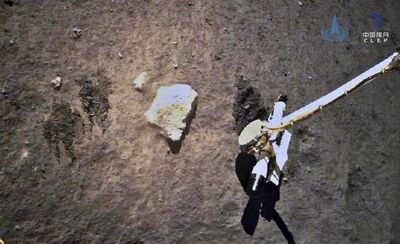
(Source: The Hindu)
Topic: Reports and Indices/Rankings
11. India ranked 111th in Human Freedom Index 2020.
- India has got the 111th position among 162 countries in the Human Freedom Index 2020.
- India has fallen 17 spots from its last ranking. It was ranked 94th in the Human Freedom Index of 2019.
- India is ranked 110th in the personal freedom category and 105th in economic freedom.
- India has got an overall score of 6.43 out of 10. It has scored 6.30 in personal freedom and 6.56 in economic freedom.
- New Zealand, Switzerland and Hong Kong are in the top three positions of the ranking. Syria is ranked last in the index.
- The United States and the United Kingdom are in the 17th position while China and Bangladesh are in the 129 and 139 positions, respectively.
- Human Freedom Index:
- It is a global index for measuring civil, economic and personal freedom.
- It is published by the Cato Institute and the Fraser Institute.
- It uses 76 indicators of personal, civil, and economic freedoms.
- This year’s index is based on the data from 2008 to 2018.
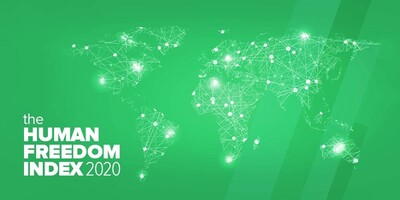
(Source: Human Freedom Index)





 17 December 2020 Current Affairs
17 December 2020 Current Affairs 








Comments